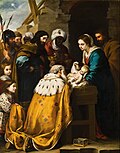Tradition
The Gospel of Matthew does not give the names of the Magi (or even how many there were), but their traditional names are ascribed to a Greek manuscript from 500 AD translated into Latin and commonly accepted as the source of the names. [3] In this original manuscript, Balthazar is called Bithisarea, which later developed into Balthazar in Western Christianity. [1]
In early artistic depictions, Balthazar was represented as a white man. [4] In an 8th century text by the author Pseudo-Bede, he is described as being "a dark, fully bearded king”. [4] From the 13th century onwards, he was occasionally depicted with black African servants. [4] Balthazar was first depicted as a black African himself in the 15th century, in European Renaissance art. [5] The increase in depictions of Balthazar as a black man from the 15th century onwards coincided with the development of the Portuguese Atlantic slave trade in the late 15th century. [6]
As part of the Magi, Balthazar followed the Star of Bethlehem first to the palace of Herod the Great, who instructed them to return to him when they had found the Child Jesus. When they arrived at the house, [7] the Magi worshipped him and presented their gifts. Balthazar gave the gift of myrrh, which symbolised the future death of a king, as myrrh was an expensive item at the time. [8] [9] Following his return to his own country, avoiding King Herod, it is purported that Balthazar celebrated Christmas with the other members of the Magi in Armenia in 54 AD but later died on 6 January 55 AD, aged 112. The feast day of Balthazar is also 6 January, as the date of his death.
Balthasar and Gaspar, another of the Magi, are characters in the 1880 novel Ben-Hur: A Tale of the Christ and the various film adaptions of the novel, which chronicles his later years.
Blackface controversy and traditional iconic representation
Many traditionally Christian countries stage pageants that include roles for the three wise men. In some European countries it is customary for Balthazar to be portrayed by a man in blackface. In the 21st century, as modern immigration increased the Sub-Saharan African population, a number of campaigns in Spain pushed for an actual black person to play Balthazar, which potentially goes against the tradition that local city councillors play the role. [15]
Since King Balthazar, in traditional pictorial representations from the Late Middle Ages, is often represented as a black person (as an integrating or cosmopolitan graphic symbol, in the tradition that the "wise men" or "magi" who worshipped Jesus in Bethlehem represented the peoples of the whole world), fitting in with this traditional icon motivated his representation in the cavalcades of Three Wise Men by a person made up in black. In many Spanish towns that custom continues, while others now ask a prominent resident of African descent to take on this role in the cavalcades. [16]
This page is based on this
Wikipedia article Text is available under the
CC BY-SA 4.0 license; additional terms may apply.
Images, videos and audio are available under their respective licenses.





